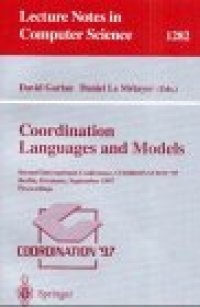
Ebook: Coordination Languages and Models: Second International Conference COORDINATION '97 Berlin, Germany, September 1–3, 1997 Proceedings
Author: Robert Bjornson Nicholas Carriero David Gelernter (auth.) David Garlan Daniel Le Métayer (eds.)
- Genre: Education // International Conferences and Symposiums
- Tags: Programming Techniques, Computer Communication Networks, Computation by Abstract Devices, Software Engineering, Programming Languages Compilers Interpreters
- Series: Lecture Notes in Computer Science 1282
- Year: 1997
- Publisher: Springer-Verlag Berlin Heidelberg
- Edition: 1
- Language: English
- djvu
This book constitutes the refereed proceedings of the Second International Conference on Coordination Models and Languages, COORDINATION '97, held in Berlin, Germany, in September 1997.
The 22 revised full papers and 6 posters presented in the book were carefully reviewed and selected from a total of 69 submissions. Also included are three invited papers. The papers are devoted to an emerging class of languages and models, which have been variously termed coordination languages, configuration languages, and architectural description languages. These formalisms provide a clean separation between software components and their interaction in the overall software organization, which is particularly important for large-scale applications and open systems.
This book constitutes the refereed proceedings of the Second International Conference on Coordination Models and Languages, COORDINATION '97, held in Berlin, Germany, in September 1997. The 22 revised full papers and 6 posters presented in the book were carefully reviewed and selected from a total of 69 submissions. Also included are three invited papers. The papers are devoted to an emerging class of languages and models, which have been variously termed coordination languages, configuration languages, and architectural description languages. These formalisms provide a clean separation between software components and their interaction in the overall software organization, which is particularly important for large-scale applications and open systems.